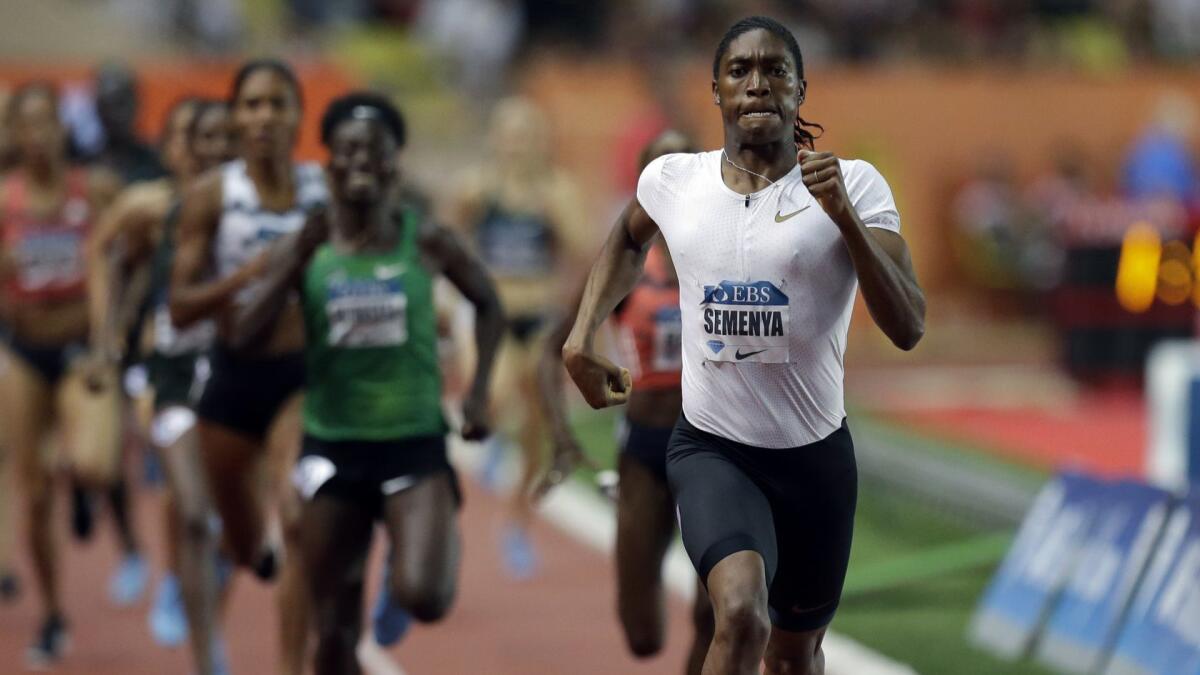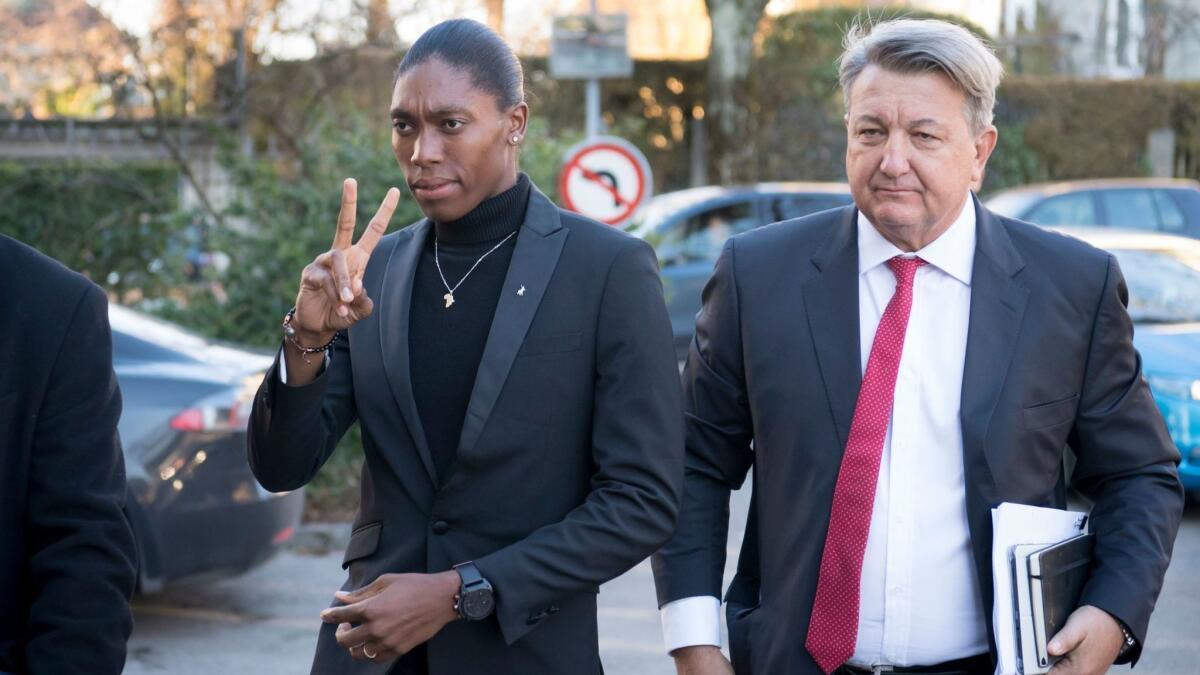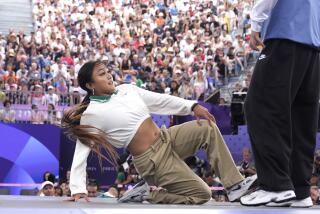In the case of star South African runner Caster Semenya, a sports arbitration court must determine the definition of a woman

- Share via
From the moment she burst into the spotlight as a teenager, sprinting to victory at the 2009 track and field world championships, Caster Semenya faced anger and suspicion.
It wasn’t just her precocious speed over 800 meters. It was her broad shoulders, the set of her jaw and muscular build.
One of her rivals, Italian runner Elisa Cusma Piccione, told reporters: “Just look at her.”
For much of the last decade, Semenya has faced claims that her physique and natural but unusually high testosterone levels give her an unfair advantage over competitors.
Track has long wrestled with issues surrounding hyperandrogenism, the term applied to a small percentage of female athletes who do not fit neatly into predetermined gender classifications. The primary question: Should sports officials determine who is — or is not — a woman?
Focusing on testosterone, a hormone responsible for strength and mass, the international track federation recently proposed that females exhibiting a “difference of sexual development” — meaning they have testosterone levels in the male range or are androgen-sensitive — must either take medication to alter their body chemistry or race against men.
It isn’t the first time the sport has sought to regulate Semenya and others like her, and the 28-year-old South African is fighting back.
The new rule, which covers events ranging from 400 meters to the mile, was supposed to take effect last November but has been delayed pending her appeal to the Court of Arbitration for Sport in Switzerland. After a weeklong hearing that CAS officials described as “cordial and respectful,” arbitrators are expected to issue a decision later this month.
While the South African government and noted athletes such as Billie Jean King and Edwin Moses have rallied to her defense, a shy Semenya has limited her comments to occasional posts on social media.
“Too fast? Too bad,” she wrote recently. “I was born to do this.”
::
People in the village of Fairlie, in the impoverished Limpopo province of South Africa, recall Semenya as a rough-and-tumble girl who usually came to school in pants instead of a skirt.
She was known for playing soccer with the boys and taking long runs by herself through the countryside.
After joining a track club in nearby Pretoria, Semenya improved quickly and soon introduced herself to the world in stunning fashion. She won that first major championship in Berlin at 18, outpacing the rest of the field by 2.45 seconds, an unusual gap for the length of her event.
The instantaneous criticism stung her mother, who told The Times: “They’re just jealous of my daughter. It’s the first girl in the black people doing such things.”
Not long after, officials demanded that Semenya undergo unspecified sex testing. After reportedly determining she was “intersex” — possessing both male and female characteristics — the International Assn. of Athletics Federations declared her ineligible.
Thus began a back-and-forth battle, with Semenya sitting out much of 2009 and 2010, then being reinstated without comment.

The following year, the IAAF instituted new hyperandrogenism standards, establishing a testosterone limit below the normal male range of 7 to 30 nanomoles per liter of blood.
Amid reports that she was forced to take medication, Semenya slipped to second place at the 2012 Summer Olympics in London. Though she was later shifted to gold because the winner was caught doping, her times continued to suffer as she dealt with injuries and coaching changes over the next few seasons.
The track federation has said that an estimated seven of every 1,000 females competing at the elite level show signs of elevated testosterone. Athletes have voiced different opinions over what should be done about that.
Some have opposed regulation. Others, such as British marathoner Paula Radcliffe, have worried that runners such as Semenya — at her dominating best — are bad for the sport.
“Girls on the start line know they’re never going to get a medal in an 800 meters,” Radcliffe recently told the Press Assn. “That’s the bottom line.”
::
When Pierre de Coubertin founded the modern Olympic Games in 1896, he did not include females.
“No matter how toughened a sportswoman may be,” the French aristocrat was quoted as saying, “her organism is not cut out to sustain certain shocks.”
It wasn’t until 1900 that 22 women were invited to participate in five sports, and not until 1928 that track and gymnastics opened the door to both genders. Officials believed that, for most events, it made sense to separate the sexes.
Segregation was tricky from the start, with the early Games marked by rumors of male athletes posing as women, and officials struggling to find a reliable measure.
At the 1936 Summer Olympics in Berlin, gold medalist Helen Stephens of the U.S. was forced to disrobe in front of officials. There were whispers about silver medalist Stella Walsh of Poland — years later, after she was shot to death in a parking-lot robbery, an autopsy reportedly showed she had ambiguous genitalia.
Female athletes from the Soviet bloc countries faced suspicion during the Cold War years as crude visual examinations gave way to a cheek swab meant to detect the inactive X chromosome that typically presents in women.
Polish sprinter Ewa Klobukowska failed such a test not long after winning medals in the 100 meters and 400-meter relay at the 1964 Tokyo Olympics. Under similar circumstances, Spanish hurdler Maria Jose Martinez-Patino was deemed ineligible before the 1988 Summer Games in Seoul.
The chromosome standard was eventually dropped because it could not account for rare conditions. And when the IAAF instituted that testosterone limit in 2011, it was later challenged by Indian sprinter Dutee Chand.
In that 2015 case, CAS arbitrators asked for more-persuasive evidence that higher testosterone equated to an athletic advantage.
The IAAF spent two years gathering data and determining which events might be most affected before announcing plans to reinstate its test last spring. Though Semenya was not specifically named, she quickly responded.
“I am 97% sure you don’t like me,” she wrote on social media, “but I’m 100% sure I don’t care.”
::
Sex is not the only example of categorization in Olympic sports.
Athletes are classified by nationality and prohibited from competing under a new flag unless they establish residency over a period of time. Gymnasts must reach a minimum age.
“You need to have some way of putting people into the categories,” said Roger Pielke Jr., a University of Colorado professor who studies sports governance. “The key difference [with gender classification] is that they are trying to look at physical characteristics.”
Though much of the scientific community believes testosterone is the primary reason for the performance gap between men and women in many sports, CAS arbitrators are not the only ones to express skepticism.
“It’s not possible to make the flat-footed statements that people want to make about the relationship between testosterone and athleticism,” said Katrina Karkazis, a bioethicist and visiting fellow at Yale who will soon publish a book on the subject. “It’s far more complicated.”
Sign up for our daily sports newsletter »
Research has identified other markers, including gonads, secondary sex characteristics and internal genitalia, Karkazis said. Individual athletes may respond differently to testosterone based on hormone receptors.
Doriane Lambelet Coleman, a Duke law professor who has focused on the Olympic movement and eligibility issues, sees no such uncertainty. As an expert witness who testified before the CAS in support of the IAAF regulation, she cannot comment on Semenya but insists that, in general, “people are wrong when they say ‘we really don’t know a lot about testosterone.’ The science on this issue is really well-established.”
Pielke also appeared at the CAS hearing, called by Semenya’s attorneys to discuss something more pragmatic.
Poring over scores of data points submitted by the IAAF, which sought to correlate testosterone levels with the results at two recent world championships, he and his colleagues discovered significant accounting errors.
“The fact that the IAAF was using in-house researchers, using bad science … does not help them portray what they are doing in a positive light,” he said.
As for the dispute over testosterone and athleticism, he believes “science is never going to answer the questions of who is a woman. The biological reality is that, despite what some people might hope or believe, biological sex is on a spectrum and it’s really hard for the IAAF because they are drawing a bright line across shades of gray.”
::
Some athletes are born with genetic advantages. For others, the level playing field tilts in their favor because they grow up in wealthy countries, with access to better coaching and training.
Yet when Semenya returned to dominance with a gold medal at the 2016 Summer Olympics in Rio de Janeiro, rivals questioned her right to compete.
“It is out of control,” a tearful British runner Lynsey Sharp told the BBC. “The public can see how difficult it is.”
From the opposite perspective, Billie Jean King has called the proposed IAAF regulation “barbaric, dangerous and discriminatory,” and a recent Nike ad showed clips of Semenya running, with the athlete asking: “Would it be easier for you if I wasn’t so fast? Would it be simpler if I stopped winning?”
As if the hyperandrogenism debate weren’t complicated enough, it has been further clouded by changing social attitudes regarding gender and the emergence of transgender athletes wanting to participate. In a speech before the South African parliament, the country’s minister of sport raised the issue of racism, saying the IAAF has targeted events in which African athletes excel.
Appearing to sense the gravity of the situation, CAS officials have characterized the appeal before them as “one of the most pivotal” in the court’s history.
No matter what they decide, Pielke wonders if it will settle the argument.
“Some people can look at Caster Semenya and say ‘I see someone who looks like the vision I have of masculinity,’” the professor said. “Others might say, ‘I look at Caster Semenya and I see a strong woman.’”
Follow @LAtimesWharton on Twitter
More to Read
Go beyond the scoreboard
Get the latest on L.A.'s teams in the daily Sports Report newsletter.
You may occasionally receive promotional content from the Los Angeles Times.











